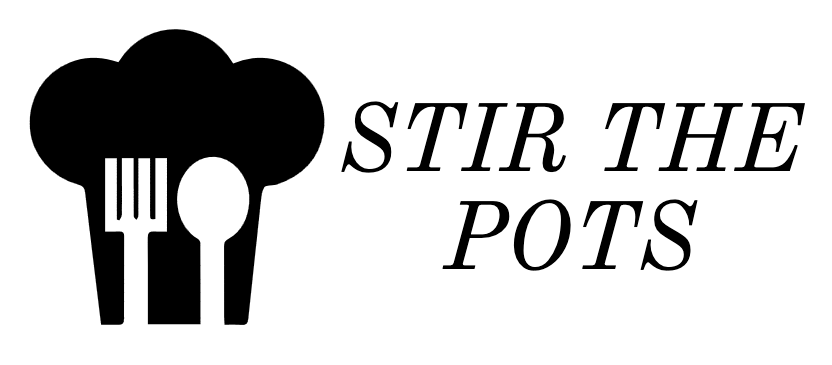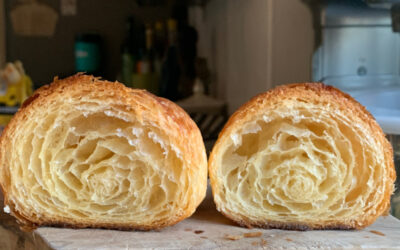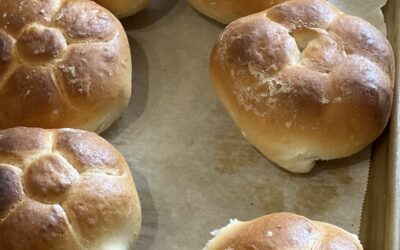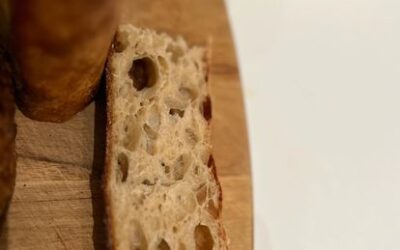I should know better by now. Sure it’s 80 degrees and muggy, and yeah, I know my wife is going to kill me, heating up our sunny Sunnyside apartment. But…this loaf is beautiful. Beautiful! And it’s probably the best German loaf I have made since school! Mehrkornsaatenbröt or multigrain bread is what this toothsome and flavorful loaf is called. Without a decent translator or any German vocabulary sufficient to really make sense of directions, I boldly went where no baker goes. In other words, I winged it. And it happens that winging it worked.
True, it certainly isn’t 100% Sauer, but it’s good. Very good. Oh, yeah, I already said that. Besides boasting, to make up for the heat I’m getting from my wife and the sun, let me just say this: I didn’t add any improver in this loaf, no vitamin c or fava bean or even soy flour which seems pretty common in some backerei breads these days. John Downes is frowning on me, but I did add yeast as a fail-safe measure, only because I wasn’t sure about the power of my rye Sauer. Forgive me mate.
Anyway, in truth I Googled a recipe, this one from some trade school named "Bandesfachschule des Deutschen Båckerhandwerks." Roughly translated, it means Technical school of German Hand work bakers. But translated the online directions make no sense at all, and don’t give any clue as far as procedure. So here is my "winging it" recipe improvised with help from my fellow bakers in Germany.
The formula:
Sauer:
90g Rye flour
72g water
5g rye sauer
16 hour proof
Soaker:
80g Rye chops
80g Oat flakes
60g Flax seeds
60g Pumpkin seeds
100g Sunflower seeds
300g Hot water
2-3 hours soak before making the final mix
Final Dough:
162g Sauer
680g Soaker
750g bread flour
10g malted barley powder
23g Sea salt
10g instant yeast, (you maybe more hardcore than I was, go total sauer. The original formula asked for 40g!)
390g Water
Sourdough:
I did a short mix 2 minutes on 1st speed and about 3 on second. I wasn’t being ambitious about doing by hand, as time was of the essence as my wife would arrive and I wanted the apartment clean and cool!
First rise: without having written down anything to check my loaves or clock, I assume I watched the news and surfed the internet about an hour, then gave the dough a turn.
One more hour passed and the dough had risen a bit, I figured that the high humidity was a factor and the rye in the Sauer. I weighed out two loaves, and shaped them like jelly roll style and placed them into two oiled loaf pans coated with cornmeal. I sprayed the loaves before and rolled them in the seed mix.
Covered them for about and hour and a half, they were booming and ready to be shoved in the oven. Baked at about 460 degrees Faranheit, my oven sucks and the thermometer is hard to read.





Nice looking bread, Jeremy. That’s fine if you added a bit of yeast to your bread. Most German breads that I have seen in Germany do have yeasts in them. Of course, there are some German breads that don’t have yeast in them as well. If you the bread as is, I wouldn’t change a thing to it.
Oops…I meant to say, “If you like the bread as is…”
Now there’s a loaf! Surely your wife will forgive you.
Susan, surprisingly enough she approved even though she asked for a thin slice, women?
Doughman,I don’t usually like using commercial yeast as I pride myself on using sour exclusively, maybe I can be flexible when a nice loaf appears!
Thanks for the comments, listen to the interviews?
Jeremy, what I was trying to tell you is that the German bakers still call their breads rye sourdough even if it has yeasts in it. Even when I took a German baking class, almost all of the breads had yeasts in it as well as the rye sourdough, and the breads had a great rye sour taste! The instructor was from Germany…he was from the Bandesfachschule des Deutschen Båckerhandwerks.
Doughman: Understood, I just wonder if that is a correct labeling of the bread; or is it a method that is used to quicken the pace of baking shortening the work load and bottom line of bakeries, it’s a subject I hope to share soon with all of you when I interview a former backer from Hamburg!
We Germans help the yeasts in the sourdough – which is always rye in Germany – you need the acid to make the rye bake, but if you want to “wait” for the yeast in your sourdough it would be toooooooo sour for some palates.
And the name of the bread has no umlaut, Brot only small breads has any Brötchen 🙂
Greetings Ulrike from Germany
Thanks Ulrike,you answered a lot of things regarding German baking. I wonder though how much German bakers have depended on yeast and how different was the bread before commercial yeast was used? Maybe that was the reason for detmold sauer method?
You tell me? I am just an eager student!
You don’t need “commercial” yeast, yeast is known for thousands of years and humans use them. The early advanced civilizations in the Middle East used yeast for their breads. I can’t say a lot to 3-stage detmold, I dont’t use it because of the exact temperatures. And rye based sourdoughs have more acid than wheat based sourdoughs, that’s my experience. Baking with rye makes the difference, you want the acid more than the yeasts to get the pentosans. So a 100 % rye bread is sour and dense. There is no strict rule about that, I grew up between German Pumpernickel and mixed rye breads …
@ all
if you are baking with a three stage sour dough, you don’t need yeast anymore.
There is enough in the sourdough.
In shorter doughs, you need it to help.
In the middle ages, bakers were using the rest of beer from the brewery, as the yeast.
Commercial yeast has been around for only 100 years, it’s like what Ulrike postetd:
we are calling small breads as Brötchen,
a Brötchen is a roll, this “name” is coming from “a little bread”
And this word is that is most used in the north.
In the south (and Austria) they calling it “Semmel”. In English it’s roll, or bun.
Ulrike, in one point you are wrong: we don’t know yeast existed for thousands of years.
It was a happy accident and observation ( random, only)
500 years ago, the human only backed flat breads between two hot stones.
They didn’t know, why it happened, why their doughs rose up.
what is sauer and where do you buy it in California ?